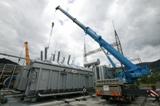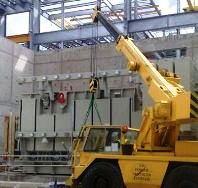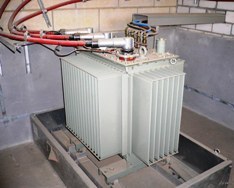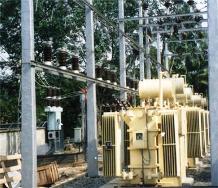Installation of power transformers
 Transformers delivered by the customer to the substation site must be oriented during transportation with respect to the foundations in accordance with the working drawings.
Transformers delivered by the customer to the substation site must be oriented during transportation with respect to the foundations in accordance with the working drawings.
Power transformers delivered to the installation site fully assembled and ready for commissioning. Only in cases where the load capacity of the vehicles and the density of the dimensions do not allow, the high power transformers are supplied with the radiators, expander and exhaust pipe removed.
Consider the basic installation operations when installing transformers in a chamber or on the base of an external switchgear.
The transformer is delivered to the place of installation by car, special transport (trailer) or on a railway platform and is installed on a foundation or in a chamber with the help of winches and rollers, and if the load capacity allows, with cranes.
 Lifting of transformers 630 kVA and above is done by hooks welded to the tank wall.Transformers up to 6300 kVA are supplied by the manufacturer oil-filled, less than 2500 kVA — assembled, transformers 2500, 4000 and 6300 kVA — with radiators, expander and discharge tube removed.
Lifting of transformers 630 kVA and above is done by hooks welded to the tank wall.Transformers up to 6300 kVA are supplied by the manufacturer oil-filled, less than 2500 kVA — assembled, transformers 2500, 4000 and 6300 kVA — with radiators, expander and discharge tube removed.
The movement of transformers on an inclined plane is carried out with a slope of no more than 15 °. The speed of movement of the transformer within the substation on its own rollers should not exceed 8 m / min.
When installing the transformer in place, to avoid the formation of air pockets under the tank cover, steel plates (lining) are placed under the rollers on the sides of the expander.
The thickness of the pads is chosen so that the cover of the transformer rises to the expander equal to 1% when the expander is installed on the narrow side of the transformer and 1.5% when it is installed on the wide side. The length of the spacers is at least 150 mm.
The rollers of the transformers are fixed on the guides with stoppers mounted on both sides of the transformer. Transformers weighing up to 2 tons, which are not equipped with rollers, are mounted directly on the base. The case (tank) of the transformer is connected to the ground network.
When installing transformers (2500, 4000 and 6300 kVA) delivered to the installation site with radiators, conservator and discharge pipe removed, perform the following work:
1) wash the radiators with clean dry transformer oil and test them according to the manufacturer's instructions for oil leakage.
The welded radiators are craned to a vertical position and the flanges of the radiator are locked with the flanges of the branch pipes of the transformer housing.Sealing gaskets of cork or oil-resistant rubber are placed between the flanges,
2) flush the expander with clean dry transformer oil and install it with a tap. It is then connected to flange seals with an oil line and transformer cover, and a gas relay is installed in the cut of the oil line. The gas relay must be tested in the laboratory beforehand.
 The gas relay body, float system, and relay cover are installed so that the arrow on the body points toward the expander. The gas relay is mounted strictly horizontally.
The gas relay body, float system, and relay cover are installed so that the arrow on the body points toward the expander. The gas relay is mounted strictly horizontally.
The oil line connecting the transformer tank to the expander is installed so that there is a rise of at least 2% to the expander and no sharp bends and reverse slopes.
The oil expander glass is located so that it is accessible for inspection and three control lines corresponding to the oil level at temperatures of +35, + 15 and -35 ° C are clearly visible,
3) flush the exhaust pipe dry transformer oil and install it on the transformer cover. A glass membrane with a rubber or cork seal and an air bleed plug is mounted on the top flange of the pipe. The thickness of the membrane wall should be no more than 2.5 mm with a diameter of 150 mm, 3 mm with a diameter of 200 mm and 4 mm with a diameter of 250 mm.
The discharge pipe is mounted on the seals and positioned so that in the event of an emergency release the oil does not get on the busbars, cable seals and adjacent equipment. To meet this requirement, it is permitted to install a barrier shield to the pipe opening,
4) a temperature sensor is installed for manometric, mercury contact and a remote thermometer with a seal of asbestos cord impregnated with bakelite or glyphtal varnish. Bushings in which mercury or mercury contact thermometers are installed are filled with transformer oil and closed,
5) fill each radiator with a centrifuge or filter press with clean dry transformer oil until it flows from the top radiator plug.
 The upper and lower taps connecting the radiators to the transformer tank are opened and the expander is topped up (with a centrifuge or filter press). Before refilling, open the plugs at the top of the exhaust pipe and on the cover of the transformer, the valve of the oil line connecting the expander to the tank, and also the edge of the cover of the gas relay.
The upper and lower taps connecting the radiators to the transformer tank are opened and the expander is topped up (with a centrifuge or filter press). Before refilling, open the plugs at the top of the exhaust pipe and on the cover of the transformer, the valve of the oil line connecting the expander to the tank, and also the edge of the cover of the gas relay.
When adding oil to the conservator, when it begins to flow from the open top caps of the radiators, the caps are tightly wrapped. Then close the plugs on the gas relay cover in the same way. After adding oil to the level in the pressure gauge corresponding to the ambient temperature, close the plug at the top of the exhaust pipe.
The oil that is added to the transformer must comply with GOST and have a breakdown strength of at least 35 kV. The temperature of the added oil should not differ from the oil temperature in the transformer by more than 5 °.
It should be noted that it is impossible to fill oil transformers with sovtol, because it is susceptible to the slightest contamination, which sharply deteriorates its properties, in particular, sovtol is highly susceptible to varnishes used to cover the plates of the magnetic cores of oil transformers.
In addition, the presence of even traces of transformer oil is unacceptable in a sovtol. Sovtol emits toxic fumes of hydrogen chloride and chlorine. Sovtoll filled transformers are therefore supplied sealed. They are filled with Sovtol only at the factory, in a special room isolated from the service personnel.
